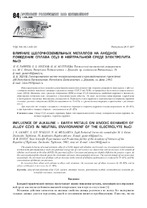| dc.contributor.author | Ганиев, И. Н. | ru |
| dc.contributor.author | Ниезов, О. Х. | ru |
| dc.contributor.author | Муллоева, Н. М. | ru |
| dc.contributor.author | Эшов, Б. Б. | ru |
| dc.coverage.spatial | Минск | ru |
| dc.date.accessioned | 2018-04-08T09:30:43Z | |
| dc.date.available | 2018-04-08T09:30:43Z | |
| dc.date.issued | 2018 | |
| dc.identifier.citation | Влияние щелочноземельных металлов на анодное поведение сплава ССуЗ в нейтральной среде электролита NaCl = Influence of alkaline – earth metals on anodic behavior of alloy ССуЗ in neutral environment of the electrolyte NaCl / И. Н. Ганиев [и др.] // Литье и металлургия. - 2018. – № 1 (90). - С. 84-89. | ru |
| dc.identifier.uri | https://rep.bntu.by/handle/data/40100 | |
| dc.description.abstract | Потенциостатическим методом в потенциодинамическом режиме при скорости развертки потенциала 2 мВ/с исследовано анодное поведение свинцово-сурьмяного сплава ССуЗ (3 мас.% Sb), легированного щелочноземельными металлами (ЩЗМ). Показано, что с ростом содержания ЩЗМ в сплаве ССуЗ потенциалы свободной коррозии и питтингообразования незначительно смещаются в положительную область. По мере увеличения концентрации хлорид-иона в электролите указанные потенциалы уменьшаются. Плотность тока коррозии и соответственно скорость коррозии сплавов с ростом содержания ЩЗМ уменьшаются на 75–85%, а с ростом концентрации хлорид-ионов – увеличиваются. При переходе от сплавов с кальцием к сплавам со стронцием скорость коррозии сплавов возрастает на 20–30%, а при переходе к сплавам с барием – уменьшается на 25–30%. | ru |
| dc.language.iso | ru | ru |
| dc.publisher | БНТУ | ru |
| dc.title | Влияние щелочноземельных металлов на анодное поведение сплава ССуЗ в нейтральной среде электролита NaCl | ru |
| dc.title.alternative | Influence of alkaline – earth metals on anodic behavior of alloy ССуЗ in neutral environment of the electrolyte NaCl | en |
| dc.type | Article | ru |
| local.description.annotation | The anodic behavior of a lead-antimony alloy (3 wt% Sb) doped with alkaline-earth metals was investigated in potentiostatic method in the potentiodynamic mode at a potential sweep rate of 2 mV/s and it was shown that with an increase in the content of alkaline earth metals in the alloy (SSUZ), the potentials of free Corrosion and pitting are slightly shifted to the positive region. As the concentration of the chloride ion in the electrolyte increases, these potentials decrease. The current density of corrosion and, accordingly, the corrosion rate of alloys with an increase in the content of alkaline earth metals are reduced by 75–85%, and the concentration of chloride ion increases. In transition from alloys with calcium to alloys with strontium, the corrosion rate of alloys increases by 20–30%, and to alloys with barium it decreases by 25–30%. | en |

